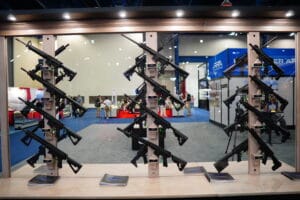California’s ban on AR-15s and other so-called “assault weapons” violates the Second Amendment.
That was the determination United States District Court Judge Roger Benitez reached on Thursday. Benitez found that the Golden State’s criminal prohibition on the sale and possession of semi-automatic rifles with certain features could not pass the tradition-based test established by the Supreme Court in its latest landmark Second Amendment case.
“In the United States, with its long tradition of gun ownership, there are no historical laws prohibiting simple possession of any type of firearm until long after the 1868 adoption of the Fourteenth Amendment. That is too late,” Benitez wrote in Miller v. Bonta. “Notwithstanding having significant time to do so, the State has identified no national tradition of firearm regulation so broad in its coverage or so far reaching in its effect as its extreme ‘assault weapon’ statutes.”
The ruling marks one of the first federal decisions on the merits of whether states may ban “assault weapons” since the Supreme Court’s verdict in New York State Rifle and Pistol Association v. Bruen. It directs the legal questions surrounding one of the most highly contentious gun regulations in American politics up the chain of federal courts, where it could ultimately end up before the nine justices.
It also marks the second time that Judge Benitez personally struck down California’s ban. He did so back in 2021 but had his ruling vacated, and the case remanded to him in 2022 by the Ninth Circuit Court of Appeals following the Supreme Court’s Bruen decision.
Benitez issued his most recent order with a standard 10-day stay at the request of California Attorney General Rob Bonta (D.). Bonta announced that he planned to appeal Judge Benitez’s decision once again to the Ninth Circuit.
“Weapons of war have no place on California’s streets,” Bonta said in a press release. “The Supreme Court was clear that Bruen did not create a regulatory straitjacket for states. Once again, this district court issued a dangerous and misguided decision and I will work vigorously to reverse it on appeal.”
Gun-rights advocates celebrated the decision and praised Judge Benitez for coming down “on the side of the Constitution and history.”
“We’ve known all along the state ban could not hold up under constitutional scrutiny,” Alan Gottlieb, founder of the Second Amendment Foundation, said in a statement. Gottlieb’s group was one of the plaintiffs in the case against the ban.
In his analysis of California’s law, Benitez first determined the guns in question fall under the protection of the text of the Second Amendment.
“Plaintiffs want to possess and carry firearms deemed ‘assault weapons’ by California Penal Code § 30515,” he wrote. “Plaintiffs are law-abiding citizens who want to possess (or keep) and carry (or bear), firearms like the AR-15 rifle that are commonly-owned for lawful purposes. The conduct is covered by the plain text of the Second Amendment. Therefore, Plaintiffs have met their burden of showing that the prohibited firearms fall within the text of the Second Amendment.”
He then turned to an evaluation of the historical analogues offered by California as justification for its ban as being part of an American tradition of gun regulation. He said that many of the laws cited fell outside the relevant time period of the Bruen test. The test requires gun laws to have been adopted close to when the Second and Fourteenth Amendments were ratified in order to shed light on the historical tradition of gun regulation because they shed light on how the right was perceived when adopted and then its protections extended to include state government action. He also dismissed many analogues because he argued they didn’t regulate firearms in a similar way to California’s modern possession and sales ban.
“The State produced a list of 316 laws covering 550 years—from 1383 to 1933,” Benitez wrote. “Many of the entries are not relevant because they came much earlier or later than the most significant time period of 1791–1868. The first fourteen laws pre-date the Second Amendment. At the other end, the last 225 laws post-date the adoption of the Fourteenth Amendment. Also, two-thirds of the State’s list (199 laws) are restrictions on use—not on possession. Here, the ‘assault weapon’ laws prohibit possession, manufacturing, giving, lending, offering for sale, etc, instead of regulating the use or manner of carrying guns. The laws challenged here impose no additional taxes on prohibited firearms, yet, the State’s historical list also includes 22 tax laws.”
Benitez also demurred at California’s reliance on bigoted historical laws that targeted the firearms rights of disfavored minority groups.
“Incredibly, the State asks this Court to treat as analogues 38 laws on the State’s list which applied only to particular disfavored people groups, such as slaves, Blacks, or Mulattos,” he wrote. “Those laws are not relevant to the ‘assault weapon’ ban challenged in this case. Even if they were, this Court would give such discriminatory laws little or no weight.”
Ultimately, he found that the state’s search for a relevant analogue was doomed to fail because Founding-era governments simply did not prohibit guns with specific characteristics the way modern assault weapon laws do.
“A historical twin is not unimaginable,” he wrote. “It could have been the case that the early states prohibited ownership of rifles and muskets with bayonet attachments or firearms capable of multiple shots without reloading. One could imagine the states prohibiting private possession of canons or Gatling guns. There were no such restrictions.”
UPDATE 10-19-2023 4:41 PM EASTERN: This piece has been updated to include comments from California Attorney General Rob Bonta.






